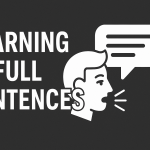I started learning English more than 20 years ago. Later I learned other languages, but unfortunately I didn’t achieve proficiency in every one I encountered. I learned my first languages in Poland using very traditional methods. In lessons, we had a lot of grammar rules and vocabulary memorization, and we rarely had the opportunity to use the language in practice. Despite the fact that everyone in the class cared most about speaking in a foreign language, when it came to stringing together a few sentences, most of us trembled with fear. Why was this happening?
When I started working for Taalhammer I spent a lot of time talking to Mateusz, the founder of Taalhammer. That’s when I learned about the term “comprehensible input,” or “comprehensible content,” in learning English and other foreign languages. The term was coined in the late 1970s by Stephen Krashen, an American linguist who studied how to learn languages effectively. It turns out that his work has had a huge impact on the way polyglots think about language learning. It began to seem strange to me that in 20 years I had never heard of him.
It’s not hard to see that in learning a language it’s not only important what you learn, but also how you learn it. Reading about what Krashen says, I learned that I had used many of his methods before, intuitively, while learning a language in a less formal environment.
If you’re interested in learning a foreign language, or you want to finally understand what teaching practices work best, keep reading!
It is certainly worth learning about the theory that many polyglots rely on.
- Acquisition vs. learning hypothesis
- Comprehensible input – one of the most influential theories on language learning
- Affective filter
- Monitor Hypothesis
- Theory of natural order hypothesis – theory of natural acquisition
- Criticism of Krashen’s theory
- The most effective teaching methods combined in one tool – learn with Taalhammer
Stephen Krashen is an American linguist, author of more than 525 articles and books on bilingual education, neurolinguistics, second language acquisition and literacy. He can converse in English, Hebrew, German, French, Spanish and Mandarin. This is excellent evidence that the theories he relies on have a lot of truth in them.
In 1982, he released a highly influential essay titled “Principles and Practice in Second Language Acquisition.” Krashen proposes that acquiring a second language mirrors the process children use to learn their first language. This process necessitates engaging in meaningful interactions in the new language, where the focus is on conveying and understanding messages rather than on the grammatical structure of the language.
Of course, as with any scientist, it’s not the case that everything he writes is the absolute truth in every detail. Krashen is a huge inspiration for changing the way we think about language learning . At Taalhammer, we agree with and actively use a large proportion of his theories (such as comprehensible input and affective filter), and are critical of others, as we write about later in this article.
Here are his five research hypotheses, which are worth knowing if you are learning a new language.
Acquisition vs. learning hypothesis
Key to Stephen Krashen’s theory are two fundamentally different processes in language acquisition: acquisition and learning.
According to Krashen, “acquisition” is an unconscious process during which elements of language are automatically acquired. This process occurs without conscious control, and new knowledge is stored in the mind subconsciously. Assimilation is that “language catching” where a person may notice that he or she has acquired some linguistic knowledge, although he or she was not aware of it during the process. Speaking the language becomes natural and effortless.
Learning, on the other hand, is a conscious process where the focus is on learning words, language structure, correcting mistakes, learning grammar and acquiring spelling and punctuation rules. The knowledge gained in the learning process is stored in the mind consciously.
If you’ve read the article “Is it possible to learn a language at any age?” then you’ve probably noticed that “learning a language” corresponds to facts (i.e. declarative memory), while language acquisition is related to intuition (i.e. procedural memory). This article also answers the question of why children are able to acquire language without learning it.
Krashen argues that assimilation, not learning, is the process that leads to mastery of a language. Mastery refers to the ability to speak a foreign language freely. According to Krashen, although learning can provide conscious knowledge of a language, assimilation is more effective and efficient in achieving communicative fluency. In his theory, real language ability develops mainly through the process of assimilation.
At Taalhammer, we use an innovative approach to teaching and learning, where you don’t mindlessly cram vocabulary words or grammar rules, but learn whole sentences. In this way, you can not only enrich your vocabulary, but also subconsciously learn grammar rules. Learn more about learning through whole sentences.
Comprehensible input – one of the most influential theories on language learning
Now let’s return to the so-called “comprehensible input“, i.e. content that you can understand despite the fact that you don’t know all the words and structures that comprise it. This is the basis of our tip about having conversations about topics on which you have something to say in your own language, i.e. your hobbies, for example.
This hypothesis has had a very broad impact on approaches to language teaching over the past 40 years and is widely supported by the polyglot community.
According to it, for true language acquisition to occur, learners must understand the message, that is, what is being said to them. For this to happen, the following conditions must be met:
- Learning materials must consist of 60–70% words familiar to the student. Krashen stresses that students should listen to texts that are a tad more difficult than their current language level. The messages should be challenging, because if they are too simple, we won’t see progress, but they also must not be too overwhelming so as not to discourage students. Many modern psychologists, such as Jordan Peterson, agree that the best learning takes place when tasks are difficult but still doable. If they are too easy, students will be bored and will not progress; on the other hand, if they are too difficult, learners will lose motivation.
- The material must be about something the student knows. This thesis is consistent with theories of familiar context. Studies show that students understand 25% more content in a foreign language if they are previously familiar with the content. Therefore, it’s a good idea to learn about things you have something to say about in your own language, such as your hobbies, work, etc. This means that you will better understand messages you have heard before in your native language. The researchers conducted experiments with learners: for example, they used the story of The Lion King, which the learners knew in their native language, and indeed the test subjects understood more in a foreign language if they knew the story before, in their own language.
At Taalhammer, we have taken “understandable content” to heart. We have arranged all the sentences in our courses in such a way that each subsequent sentence builds on the previous words or sentences. By learning this way, you will always understand at least 60–70% of the material presented. As a result, you won’t focus your attention on what each word means, but more on why the words are arranged in the order they are, and not in any other order. What’s more, the listening and reading texts use mostly words and sentences from the course, so you will also understand about 85–90% of the text.
Affective filter
We have written before about how personality traits affect success in language learning. Krashen says that it is not true that students who master a language faster have talent or so-called linguistic aptitude. It is the students who have problems who have something extra. Krashen is talking here about the so-called affective filter, i.e. something that creates a “thought block.” It could be, for example, fear of making mistakes, poor self-esteem, lack of motivation, lack of self-confidence, or expecting perfection from oneself. In contrast, people who are confident, have a lot of motivation and are characterized by having little to no anxiety learn faster and are successful in language.
If you are one of those who have trouble speaking a foreign language, stop here and read the above paragraph again.
We know from experience that speaking is what causes the most trouble when learning a foreign language. That’s why our courses are structured to prepare you to speak from day one. This way you can work on yourself and counteract your “filter.” This will be especially helpful if you are an introvert, have low self-esteem, and want or need to start speaking as soon as possible. You will quickly notice that just the fact that you take up talking will increase your motivation and confidence, because you will prove to yourself that you can.
Monitor Hypothesis
As you already know, language acquisition is the process that is responsible for our fluency in using language. On the other hand, conscious knowledge of learning, or “facts” (e.g., grammatical rules), act as a “monitor” or “equalizer.” Krashen notes that the effectiveness of the “monitor” is limited, and overuse can even disrupt the fluidity of communication.
What does this mean in practice?
Very often when we want to say something in a foreign language, the given sentence comes from our subconscious. However, before it is uttered by us, there is a so-called “monitor” that will want to check and possibly correct errors to determine whether the sentence is correct.
Has it ever happened to you that you had a sentence already on the tip of your tongue, but instead of saying it you started analyzing it? That’s what your “monitor” is. The assumption is seemingly a good one, but in practice we very often end up saying nothing, because we start worrying more about the correctness of the statement than the communication itself. We would rather say nothing than risk saying something with a mistake. This is what loses us and hinders our further development.
And, after all, learning a language is about being able to communicate, not about speaking correctly.
Think about children. Have you ever seen a child who is concerned about being correct in their native language? Probably not. And this is because children do not have a “monitor.” They just speak and that’s it. And that’s where their genius lies.
Theory of natural order hypothesis – theory of natural acquisition
Linguists since the early 1970s have pointed out that the process of language acquisition proceeds in predictable stages. It is true, for example, that a child will learn the present tense earlier than the past tense. Stephen Krashen, based on the research of others, formulated the theory of natural sequence of acquisition.
The essence of this theory is that there is a specific order in which different elements of grammar are acquired.
For example, in the context of English, Krashen points out that verb forms with the ending “-ing,” used in the continuous tenses, are acquired relatively early by children learning English as their first language. In contrast, the third person singular form, where the ending ‘s’ is added to the infinitive, can be acquired as much as 6 months to 1 year later.
For adults learning English as a foreign language, earlier acquisition of verb forms with an ‘-ing’ ending is also observed. However, according to Krashen’s observations, there is a tendency for the third person singular form to be skipped or assimilated much later than is the case for children learning their native language.
The theory of natural assimilation is Krashen’s most criticized theory. In fact, he himself notes that this theory mainly applies to children and the acquisition of the native language. In the case of instructional learning of a foreign language by adults, the process may be governed by completely different laws.
Our own observations confirm this. One of our users began learning the language by reading Disney stories, which are written mainly in the past tense. So it was no surprise that this user spoke only in the past tense from the beginning, thus violating Krashen’s assumptions.
However, this is not the only criticism, as discussed in the next section.
Criticism of Krashen’s theory
Over the past several years, discussions of Stephen Krashen’s theories of foreign languages have been noticeable in the scientific community. In particular, the theories of comprehensible content and language acquisition, which are key concepts in the field of linguistics and language learning, have gained popularity.
Although these theories are popular, they are often criticized due to the following aspects:
Lack of evidence on adult acquisition
There is no empirical evidence that language acquisition can occur among adults without any conscious language learning. That is, there is no indisputable proof that someone over the age of 15 who is only exposed to content, but does not try to speak or learn vocabulary words, can learn a language at all. The studies conducted, according to critics, were not rigorous enough, or did not provide conclusive results. Krashen’s hypotheses seem to mainly apply to a child’s first language.
Exposure to the language of the environment as the only form of learning works for children when learning their first language, but so what? Children are at a completely different stage of development and so their language learning process looks completely different. We described this in our article “Is it possible to learn a language at any age?“
For an adult, getting to the point where language becomes intuitive is a very difficult task. Every word or grammatical structure has to go through short-term memory and then declarative memory. This means that for adults, learning, and therefore acquiring facts, is always the necessary beginning of language acquisition. In the beginning, we must learn the facts, and only later, through their use and listening, will a more intuitive, fluent language be developed.
An oversimplified view of language acquisition
Krashen’s theory focuses mainly on comprehensible language input, which, according to critics and backed up by our research, does not take into account the role of other key factors such as motivation, preference, or practice during the language learning process (including learning vocabulary, grammar, sentences, etc.).
The very idea that a language can be learned easily and pleasantly just by listening to “comprehensible content” is not supported by reality. It is worth mentioning here Robert and Elizabeth Bjork, who speak of “desirable difficulties”. According to this theory, the learning process is ultimately more effective when a person encounters certain difficulties in the course of learning. This slows down language learning, but in the long term it leads to much greater success. In practice, this means that certain challenges, mistakes or difficulties can lead to better learning than effortless and easy tasks. Bjork argues that difficulties can act as a kind of “exercise for the brain,” making skills more durable and better remembered.
According to Krashen, conscious learning acts as a monitor and “controls” the language, so to speak. According to the researcher, the monitor does not contribute to students’ acquisition of language and usually interferes with learning. Some researchers believe that this hypothesis oversimplifies the role of conscious learning, overlooking its impact on the effectiveness of language learning.
Overlooking the importance of interaction with others
Critics note that Krashen focuses excessively on the input side, overlooking the importance of output, i.e. language production and interaction with others. And it is interaction with them that appears to be crucial to learning to speak a foreign language. Patricia Kuhl, professor of speech and hearing sciences, has shown that children learn language from people, not from screens. Exposing English-speaking children to interactions with someone speaking Mandarin to them helped these children retain the ability to distinguish the sounds of Chinese, but when the same “dose” of Mandarin was delivered through a TV program or audio recording, the children learned nothing.
Patricia Kuhl
You may find it interesting to watch the presentation “The linguistic genius of babies”:
Language has always evolved as a means of communication between people, and it seems that interaction is essential for acquisition to occur.
Moreover, we become good at what we do. So we need to talk to develop this skill. If we don’t, we won’t achieve linguistic success.
The most effective teaching methods combined in one tool – learn with Taalhammer
Despite the caveats presented, Krashen’s theories have numerous supporters, and it’s worth drawing on their elements, adapting them to individual needs and the context of language learning.
At Taalhammer, we don’t want you to waste time. Instead, we want your learning to be effective and personalized. So we’ve done your homework for you and created an app that combines the best learning methods, pulled together into a single, effective whole that you can put into practice.







